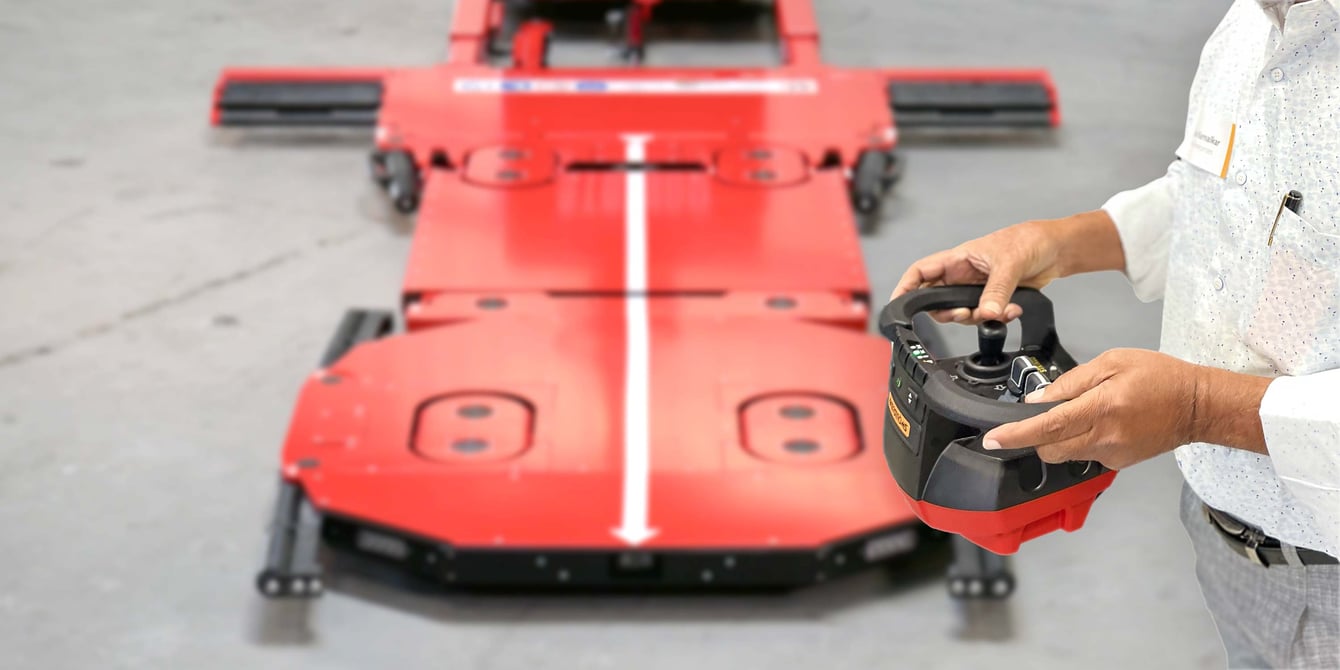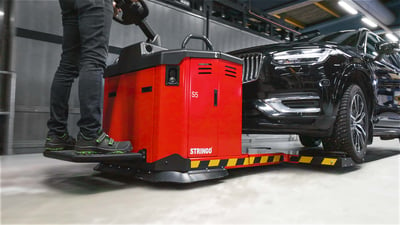How do you move a car remotely? What situations require a remote-controlled vehicle mover? And how far away are self-driving vehicle movers from becoming a reality? Get the latest insights from an industry expert.
When the automotive industry evolves, so do the products that support it. Tomas Holmgren is a System Design Engineer, an expert at electronics and technology in Stringo’s R&D department. One recent update from his team is the option to operate a Stringo vehicle mover remotely.
“We’ve connected our most recent model to a remote control, much like the ones used by crane operators on building sites. This way, our customers can easily manoeuvre their Stringo from a distance of up to a hundred meters, or 330 feet,” Tomas explains. “In fact it’s even safer as the operator isn’t on the vehicle mover and thus fundamentally it has that benefit,” he declares proudly. “And as we’re a safety solution, that has exciting possibilities.”
The main driver behind this development is the shift to EV production. But as is often the case in product development, the solution to one challenge ends up being applicable to others. Below, Tomas shares some current and potential use cases for moving vehicles remotely.
4 challenges that remote-controlled vehicle-moving helps tackle
1. Getting EVs out of testing facilities in case of battery overheating
“At Stringo, most of the inquiries we get for remote-controlled vehicle-moving come from manufacturers of electric vehicles. During the EV testing process, there’s a risk of the vehicle’s batteries getting overheated, which can cause what in the industry is called thermal runaway and fires that are extremely difficult to put out. Suppose the testing engineers detect that a battery is reaching a high-risk temperature. In that case, they can use a remote-controlled vehicle mover to quickly get the car out of the facility without manual manoeuvring. Or, if the situation requires the whole building to be evacuated, let specially trained firefighters remove the car.”
2. Avoiding electrocution hazards when moving crash-tested EVs
“After a crash test, high-voltage components in EVs can cause electric shock if you touch the vehicle. That’s another specific situation where remote controls are useful to move a damaged vehicle without being near it.”
3. Moving cars inside climatic test chambers without compromising environmental variables
“When testing a vehicle under specific conditions, you want the environment in the dyno cell or climatic chamber to remain as intact as possible. Remote-controlled vehicle-moving allows you to move a car inside the testing chamber without opening it. Otherwise, your testing parameters risk being compromised, and you’ll waste valuable time getting them back to where you want them.”
4. Precision parking with a full overview of your vehicle
“Traditionally, when using a Stringo vehicle mover, you stand on a ride-on platform. This procedure is great for operator safety but not for seeing behind the car. A remote control lets you walk around the vehicle and see it from all angles. This way, you can place it with high precision without stepping off your Stringo to check how far you are from a wall, for example.”
What are the main risks of remote vehicle-moving?
“In some ways, remote manoeuvring increases operator control,” says Tomas. “But it can also amplify some of the safety hazards of moving vehicles. When you’re on the floor instead of on the ride-on platform of the Stringo, there’s a potential risk of getting crushed or run over by the vehicle you’re moving. To prevent accidents like these, we’ve implemented an emergency stop function. If the Stringo should lose the connection with the remote control, or if the operator falls over while holding the control, the Stringo will automatically come to a halt.”
What’s next – a self-driving vehicle mover?
According to Tomas, AGV, or fully autonomous transportation of cars, is the logical next step in his team’s product development. In fact, Stringo’s most recent vehicle mover models are already technically prepared for this update:
“On the older Stringos, the handle controls the drive wheel, which makes the manoeuvring mainly mechanical. Our latest models have a purely electronic ‘steer by wire’ system. This opens up possibilities beyond just remote-controlled operation. By connecting CAN bus and AGV systems to these new Stringos, we’re not far from producing a fully self-driving vehicle mover. We could also fit the Stringo with a camera system that provides the remote operator with a 360 view on a computer screen”.
Areas of use for automated vehicle-moving
Getting back to EV testing and the need to get overheated cars out before a fire can spread, a self-driving vehicle mover could improve both speed and safety, says Tomas:
“Ideally, there would be a pre-programmed ‘evacuation mode’ that you could activate if the battery exceeds a dangerous temperature level. That way, the vehicle mover would automatically transport the vehicle out of the building and to a safe location without any human interaction”, he explains.
A less dramatic use case is improving efficiency in non-traditional car manufacturing.
“In production facilities where setting up a classic assembly line isn’t a feasible option, self-driving vehicle movers could speed up transportation between workstations,” Tomas concludes.
Want to learn about more automotive trends?
Don’t miss our article explaining the growing demand for moving cars on slopes.





